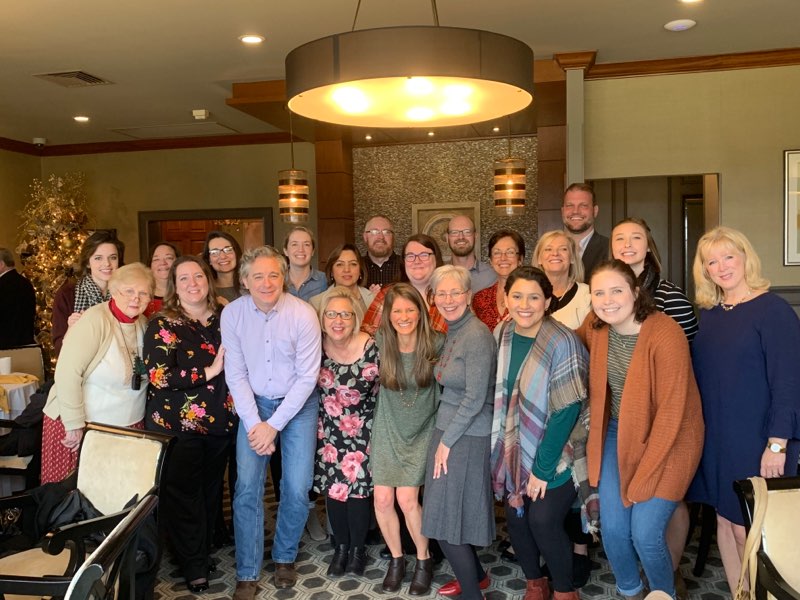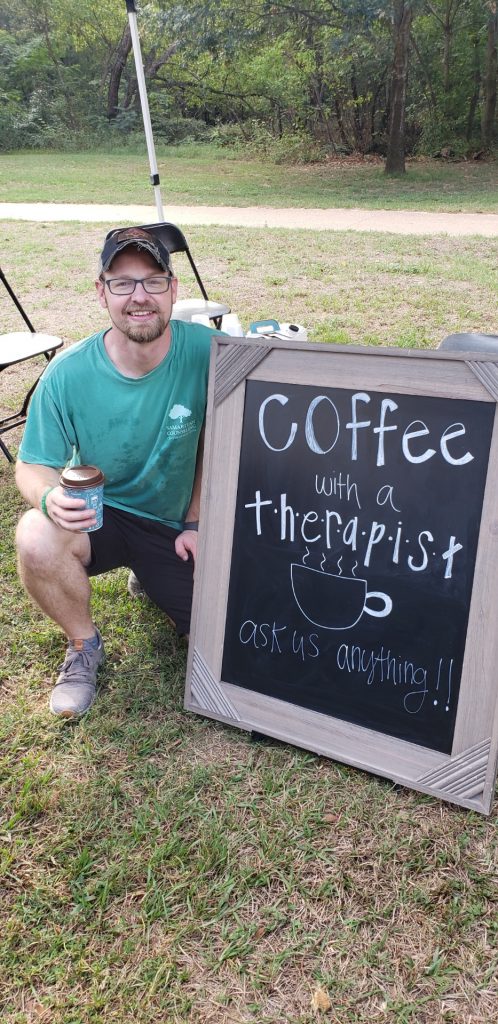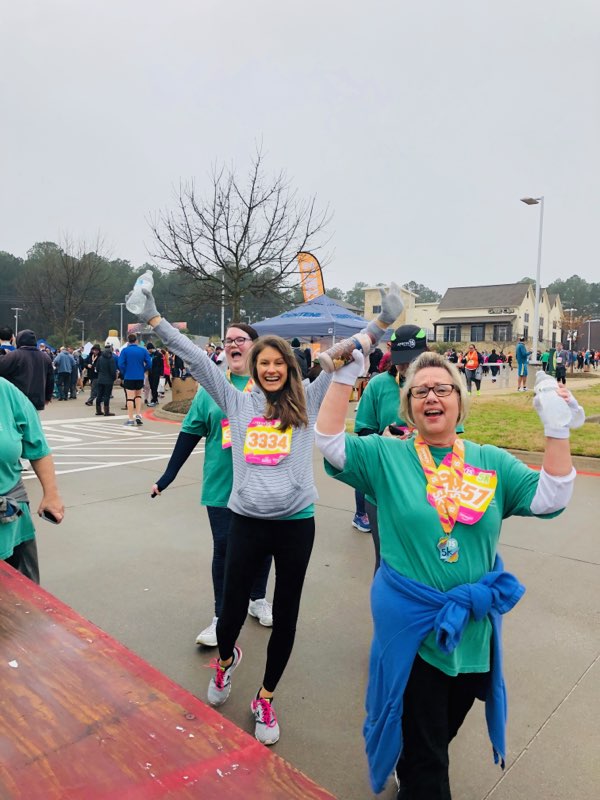
Two days before Judge Moran announced Smith County’s stay-at-home order, I did what now seems unthinkable. I marched to the Samaritan Counseling Center door in person and enjoyed a face-to-face interview in a comfy chair, topped with a fluffy pillow. The room was cozy and so quiet, I could hear the clock ticking.
Brittany Gayetsky, director of clinical operations at Samaritan Counseling Center of East Texas, sat across from me in a wingback chair, a phone-turned-recorder between us. Her therapist’s skills were at play, even while being interviewed. After 45 minutes of her soft-spoken, knowledgable and thoughtful responses, I felt calmer. Here is her story in her own words, edited for clarity and length.
“I’m Brittany Gayetsky, the director of clinical operations at Samaritan Counseling Center of East Texas. I’ve been with Samaritan for the past five years in the capacity of a psychotherapist and transitioned recently into the role of clinical director. I see between five and 10 clients per week.
Prior [to COVID-19], the vast majority of our clients were being seen in person. All of our therapists practice in a variety of modalities and were going about their normal routines. After Smith County’s stay-at-home order went into effect, we stopped seeing any clients in person and went exclusively to video-based and phone counseling. Our therapists are reaching out to their clients in between sessions when clinically appropriate, and clients also have an after-hours phone number they can use for support.
Our therapists have set up offices at home. Many of the things we do in person can also happen with that web platform. We use one called doxy.me. It’s HIPPA-compliant, completely private and doesn’t create any sort of recording of the session.

We have modified and simplified our intake process so that people can be seen sooner, and there are fewer barriers to support. With new clients, I’m conducting an interview over the phone before we schedule them for their first appointment to assess risks to ensure this is the best level of care for them right now. It’s very particular questions about levels of risk, also about safety in their environment and home conditions. Say they were potentially in domestic violence situations or had some family struggles at home. We, of course, want to make sure that we can help them create the safest environment.
We have a lot of privacy, of course, in a counseling room. Part of the challenge has been thinking about and helping with interruptions that would never be an issue coming physically to a counseling center. Little things, like having kids at home running through the room, and making sure our clients have a way to indicate to us if they are unexpectedly not in a private place. We try to coach them for ways of getting privacy at home. We have some clients who conduct sessions from their cars or from their backyards. And then, of course, if there is a problem with an internet connection, and they can’t do video-based, then we move to a phone session.
Some folks who have needed care for a while are calling in, and they are in a lot of distress, but the most appropriate level of care is actually hospitalization. We reached out to our local healthcare systems with services that are tailored to their needs. We would like to provide acute stress care, which aims to give short-term support as needed to people in extraordinary circumstances. We hope to organize support groups via video, shortened sessions and expanded Employee Assistance Program offerings.

For therapists where they have an existing relationship, it seems to be pretty easy to create that therapeutic bubble, even if they’re meeting remotely. When we’re working with clients, there’s this movement that happens where you might be moving from everyday speech to more depth. They’re talking about things that are very close to their hearts or sometimes very painful or challenging, and it sort of feels like a settling or a deepening. It feels like a certain sense of flow in the session itself. There is a sense of what’s happening here and now is precious. That to me is what the therapeutic bubble feels like, and it can still exist remotely. I much prefer to meet in person with my clients and have been proven wrong. There can be significant intimacy and significant therapeutic gains through e-counseling.
Sometimes I’ll conduct a session with an existing client, and we will have been working some very specific themes. Those themes feel very much set aside to talk about what’s happening in the here and now and what’s happening in their families and their current concerns and worries and overall sense of anxiety. Sometimes, the fact that there’s a little less frenzied busyness in life can make way for a deeper session. For folks that are used to a lot of busyness, and that busyness shifts, then we actually see some more deepening.
There also has been a way to work creatively with this video modality that I wouldn’t have expected to enjoy so much. I have lots of clients who have pets at home that are important to them or particular artwork. My clients now are choosing where they want to have therapy within their homes. They are able to show me some things from their life that they weren’t able to show me when they were coming here to the counseling center. In certain clients, that actually ends up conveying a greater sense of intimacy because they can share from their homes. So, it has come with more blessings than I would have imagined.

I wish I could offer anxiety relief in the community. My great hope is from this will arise a greater sense of solidarity with everyone in the community because we all are experiencing this together. It’s going to touch some households in a much more profound way. I do hope that a collective response can be encouraged. There are also very practical things people can do. There is already a real difficulty with social isolation generally. It is a huge problem and usually makes any kind of diagnosed mental illness worse. I’d love it to be a time where people reach out by phone or by video to their neighbors and loved ones and extended family. We need each other; we need good, healthy relationships with each other.
There are hundreds of resources online. Samaritan is one of them. We’ve been creating some new video content the last few weeks to share some of the exercises we do for our clients in session: breathing exercises and guided imagery and helping people get in their bodies and breathe in ways to lower that anxiety response.
We already have a problem [in East Texas] with folks accessing the care they need. A big challenge in this region is not having enough psychiatrists. My fear would be that the isolation that comes with social distancing would exacerbate existing mental problems. I worry a lot about our older population in Tyler because coronavirus impacts them medically the most, but also social isolation is a huge problem for our older population. I do think that local agencies and hospital settings are doing the best they can to respond.
We are fortunate that we can continue to deliver care for as long as this lasts, as long as we continue to be sustained by some donor support. That is a huge challenge to any nonprofit. We fund our services through client fees and also generous donations through the community and some foundation grants. We are in need of community support as we respond to this crisis and help people through it.”
Love what you're seeing in our posts? Help power our local, nonprofit journalism platform — from in-depth reads, to freelance training, to COVID Stories videos, to intimate portraits of East Texans through storytelling.
Our readers have told us they want to better understand this place we all call home, from Tyler's north-south divide to our city's changing demographics. What systemic issues need attention? What are are greatest concerns and hopes? What matters most to Tylerites and East Texans?
Help us create more informed, more connected, more engaged Tyler. Help us continue providing no paywall, free access posts. Become a member today. Your $15/month contribution drives our work.







